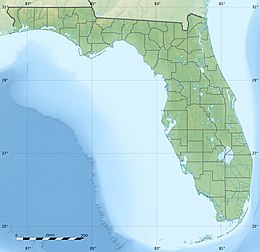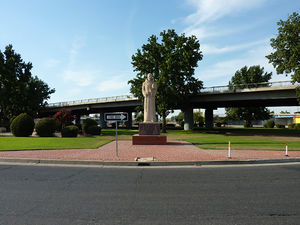Orville Vogel
Orville Vogel (1907–1991) was an American scientist and wheat breeder whose research made possible the "Green Revolution" in world food production.[1]
Life and career
Orville Alvin Vogel was born in Pilger, Stanton County, Nebraska, one of the four children of William and Emelia Vogel. He graduated from high school in 1925 and received bachelor's and master's degrees from the University of Nebraska-Lincoln in 1929 and 1931, respectively. He married Bertha Berkman in 1931 and began his career as a wheat breeder at Washington State College (now University) in Pullman in 1931. Vogel worked for the U.S. Department of Agriculture's Agriculture Research Service at Washington State University for his whole career, from 1931 to 1972. In retirement, Vogel established a fund to help finance wheat research. He and his wife, Bertha, matched donations to help launch the fund. Vogel died of cancer in 1991.[1]
Role in the Green Revolution
Cecil Salmon, a biologist working in post-World War II Japan, collected 16 varieties of wheat, including Norin 10, which was developed by an agronomist Gonjiro Inazuka in Iwate Prefecture to be very short, thus less likely to suffer wind damage. Salmon sent them to Vogel in Washington in 1949. Vogel began crossing Norin 10 with other wheats to make new short-strawed varieties. Vogel led the team that developed Gaines, the first of several new varieties that produced 25 percent higher yields than the varieties they replaced. Vogel shared his seeds of Norin 10 and Norin 10/Brevor 14 cross with Norman Borlaug, who later received the 1970 Nobel Peace Prize for his role in the “green revolution.”[2] Borlaug publicly acknowledged Vogel's contributions to his research.
Honors and awards
많은 영예 중 보겔 박사는 1975년 국립과학훈장, 1987년 워싱턴 주 최초의 공로훈장, 필라델피아시가 수여한 1990년 존 스콧 상을 받았다. 그는 1987년에 농업 연구소의 과학 명예의 전당에 헌액되었다.[1] 워싱턴 주립대학은 보겔의 이름을 따서 의자와 건물을 오르빌 A라고 명명함으로써 보겔을 존경했다. 보겔은 밀 사육과 유전학 분야의 의자와 오르빌 A를 수여했다. 보겔 플랜트 바이오 과학 빌딩.
참조
- ^ a b c Howe, Marvine (April 15, 1991). "Orville Vogel, 83, Leading Researcher Of Wheat for U.S." The New York Times. Retrieved 2009-12-16.
- ^ "The story of Wheat. Ears of plenty". The Economist. December 20, 2005. Retrieved 2009-12-16.


